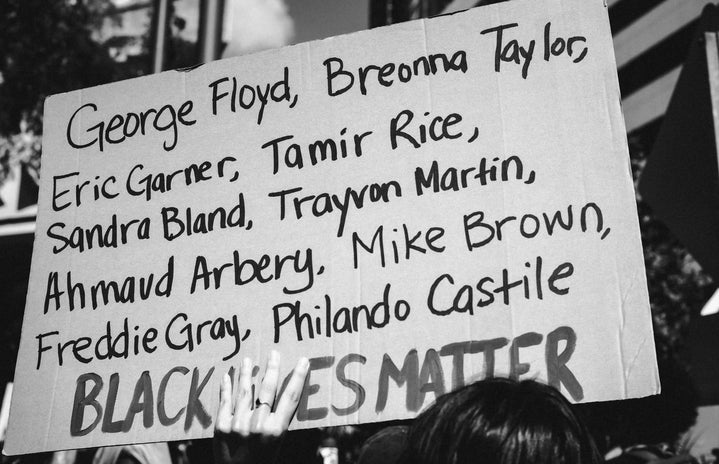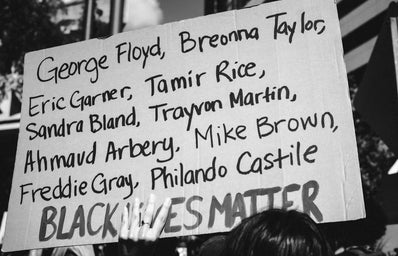There are two pandemics currently taking the nation by storm. One is a pandemic caused by a virus and the other is the most culturally prominent pandemic: the wave of violent and tragic killings of Black people across the nation. I am a part of a racial minority in this area of Winona, yet I acknowledge that I do not experience the same types of things that Black people go through. I wanted to share my understanding of the problem underlying current racial tensions that recently led to public outcry and protests around the country.
Lately, many people have seen these outrageous murders of Black individuals, often by police officers who are in positions of power or by White men who may be racists or supremacists. These individuals have the right to carry a lethal weapon in this country, which can mean death for any person of color who looks like they’re not in the “right place.” These victims, who represent only a small portion out of a large number of deaths, include Ahmaud Arbery, who was chased and shot down in the street by men in a truck just for jogging in a predominantly white neighborhood, George Floyd, whose neck was kneeled on by an officer which led to his suffocation and death, after being accused, only twenty minutes earlier, of purchasing items with a $20 bill that only looked counterfeit, and 23-year-old Elijah McClain, who was detained and injected with ketamine for looking “suspicious,” while walking home in a face mask as a result of symptoms from anemia.
These men have gone too soon.
They all had families and a whole future ahead of them, yet they died young in inhumane ways. At some point, you may ask yourself, “why is there such an unproportionate number of Black men’s faces on television who have died under these conditions while you rarely hear about White men beaten, shot, and choked to death on a daily basis?”
All of these victims had one thing in common besides the color of their skin—they were killed and weren’t given a chance to defend themselves in the court of law. The punishment was presumed guilty upon arrival.
Multiple events like these have come to national attention in just a span of a few months, largely due to social media. And even without media showing these grievances, events like these happen every day. 28% of those killed by police are Black people; however, they make up only 13% of the US population, according to a web source titled Mapping Out Police Violence. According to this source, Black people are also three times more likely to be killed by police than White people with a 6.6% homicide rate compared to the rate of White people which is 2.5 percent. And before you try to justify those deaths, saying that those Black victims committed crimes or broke the law—more than 1,000 unarmed people died as a result of police harm between 2013-2019. One-third of them were Black. Most importantly, these men mentioned above were not breaking the law when they were killed by police. They were killed due to the color of their skin and implicit bias.
Even if those Black men did commit a crime, that is no excuse to have the police show up, beat the life out of them and kill, which law enforcement decided to do when those men did not commit any certain crime.
That fact alone says a lot.
This serves to show that there is an obvious and inherent bias against people of color, even if individuals don’t recognize it within themselves. And we need to change that, as well as the way we view and treat Black people.
Part of the issue is that the deaths of Arbery, Floyd and McClain were results of systemic racism and implicit bias, which is not immediately caught by first-glance. We think racism is a threatening force of racial slurs or lynching— the most obvious forms. People are inherently racist, most often unknowingly. From what we are taught by American society, biased systems and whitewashed history, we are taught to have a bias and superiority over Black people.
It is learned and stems from the long-standing impact of slavery, Jim Crow, segregation and other racially-distributed systems. The legacies of systemic racism have left communities segregated even today, creating a pool from which we form relationships and social circles. Research shows that those relationships and experiences, which came from social circles, play a big role in influencing hidden biases. They can start forming in children as young as six years old and are reinforced later in life through social settings and mass media.
For instance, according to a Pew Research Center Survey, while nearly 84% of Black Americans agree that slavery still negatively affects Black people in society today, only 58% of White Americans say the same. This emphasizes how Black Americans are still affected by the outcomes of those long-gone racist institutions in forms such as microaggressions, negative stereotypes and depictions of themselves in the media or culture.
Meanwhile, some White Americans retain the mindset of “Never affected me. It’s not a problem.” So when these Black men are immediately hunted down and killed by these predominantly White men with no evidence to lead, except dark skin and “suspicious” reports, can you completely deny that their deaths resulted from an ingrained mindset formed by the history of our racially prejudiced society?
Black people have been prominently vocal for years about wanting to change and escape the oppression and injustice they face every day, only for it to be watched and ignored. We ignored it in 1963 when MLK was arrested, imprisoned and suppressed for speaking the truths and pain felt by his Black community.
We ignore it today when it took four months for Ahmaud Abery’s murderers to get arrested. It took almost a year for Elijah McClain’s death and injustice to gain national attention. We’ve been listening but not actually understanding their perspective and taking action to prevent these injustices. Those of us born with light skin watch the videos with disgust and say “Horrible. That’s too bad.” And we continue to live our lives without a trace of fear of being put in a chokehold and kneeled upon until death.
Meanwhile, the influx of the news of violent racist attacks builds on an already daily fear of what Black people fear most—that they will be the next victim in a viral video. We all know and see these injustices, but the issue at hand that many of us hate to admit is that we are bystanders. We gain sympathy for Black people due to these events, yet many of us don’t know how or don’t take preventative action against these horrible outcomes of racism. Yes, you can show support online with sympathy and prayers, but it’s not enough to simply acknowledge the pain of the people in the Black community, move on, and not put the effort in understanding their fight or changing the racially biased mindset many of us carry.
You might say, “All this takes too much work. Why should I care when I’m not affected, and why try when these things just keep happening over and over again?”
In response to that, we all should take measures to learn and educate ourselves on preventing the ways Black people are being continually mistreated. There are books, videos and easily accessible websites available that hold many opportunities to learn more. If you choose not to divulge in the matter, you continue to live in a blissful world of ignorance that prefers to savor the fact that your skin color will never be the main cause of your struggle. Know that when you are okay with your boss turning down a perfectly qualified Black man for a job, preferring someone “more professional” or when you say “Of course that Black boy got shot by officers without evidence. He was probably part of a gang,” you become one of the many reasons why Black people protest and shout their grievances, which they have the right to do while you sit and do nothing.
When people listen but don’t take action for so long, enough is enough. So what these “change” activists are talking about is understanding, lifting and spreading a voice in what Black people have struggled to do over the years of oppression and racial barriers. Without participation, the decades of pain and anger felt by the Black community will worsen, and yes, injustices will continue to escalate.
So now, more than ever, with the spotlight on all of these events, it’s time to deconstruct the beliefs on race which society ingrained in us. Learn about the history of oppression of Black people, white privilege and the different forms of racism you pass by every day. Call out and challenge even the smallest acts of bigotry you see. Educate yourself and have difficult conversations, even with those who think differently from you.
To my generation that is familiar with technology and social media, take advantage of the educational sites that give you the opportunity to learn more about race, privilege and the issues that Black Americans face that we may have never heard of. Learn to not BE racist, but ANTI- racist.
All in all, know that with your inborn white privilege, you have the power to change and reform the way our society views and treats Black people—it’s only with justice, activism and action that we can progress and change.
To learn more about the statistics featured in the article, feel free to read these three additional stories from Mapping Police Violence, U.S. News and the Pew Research Center.


